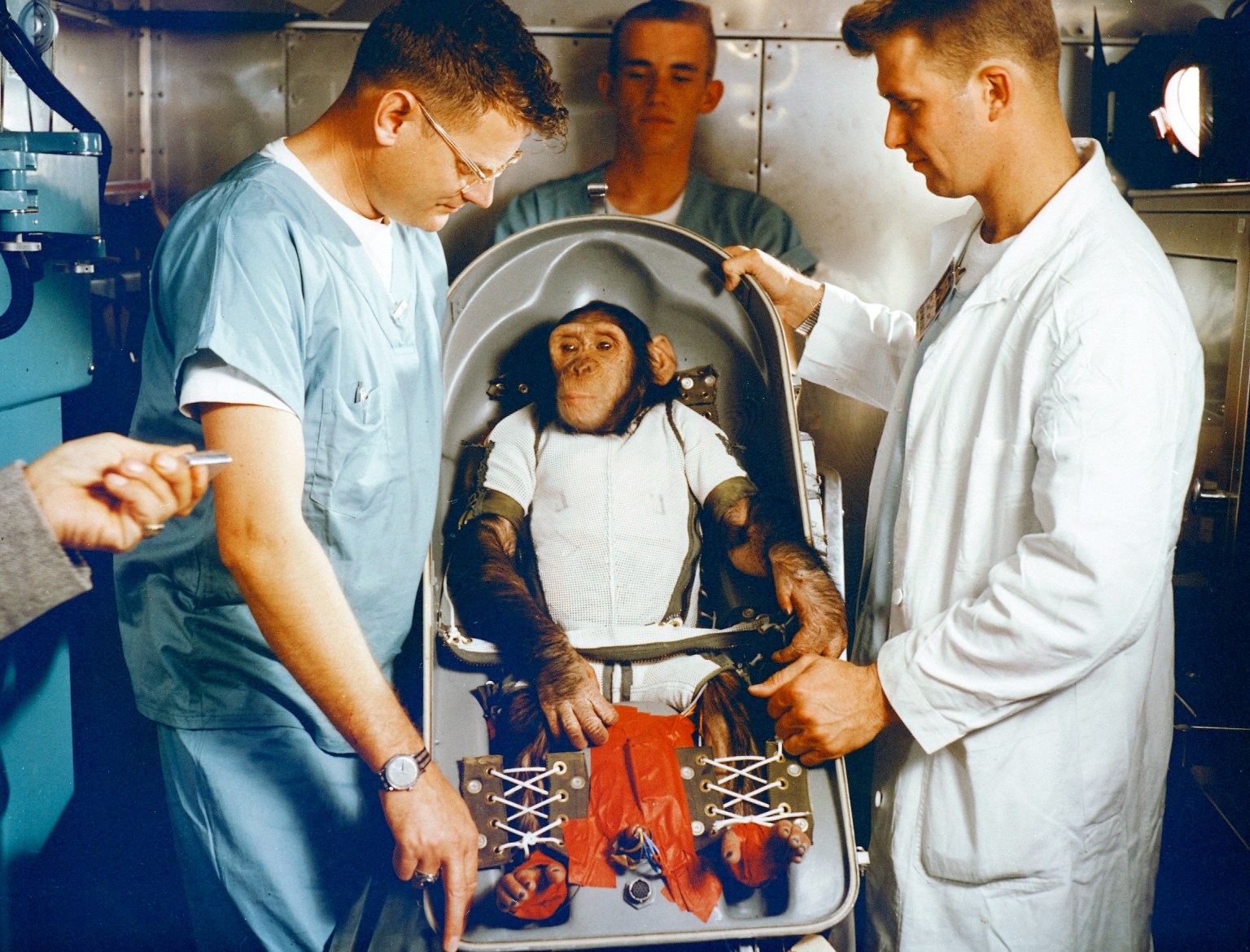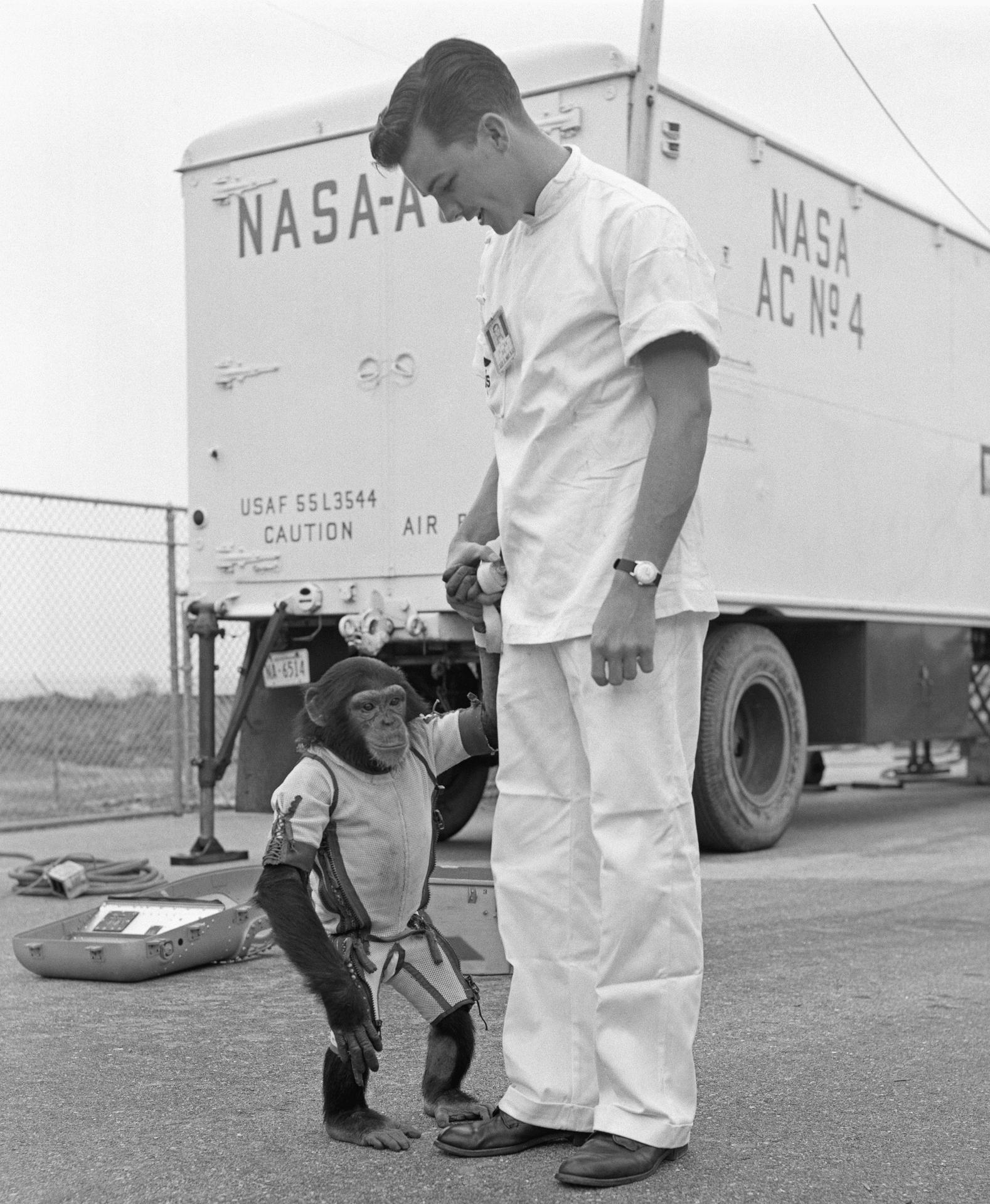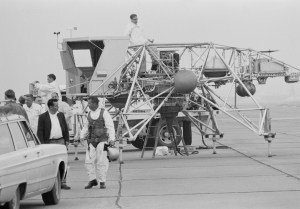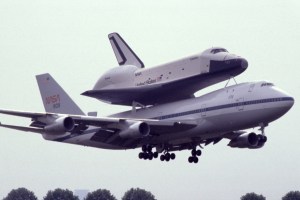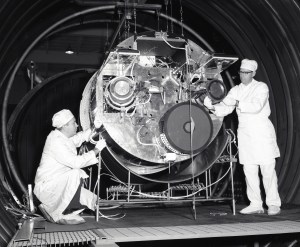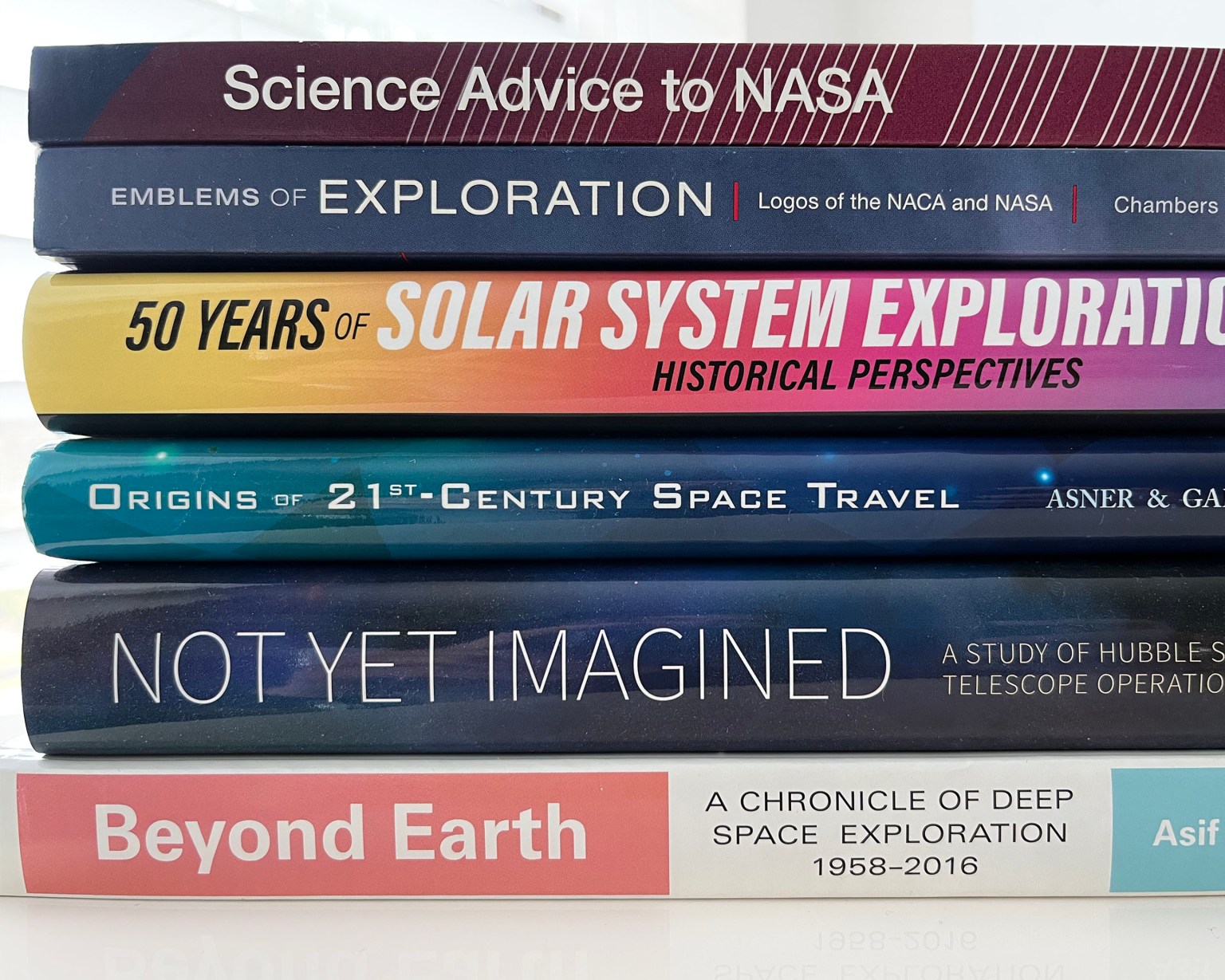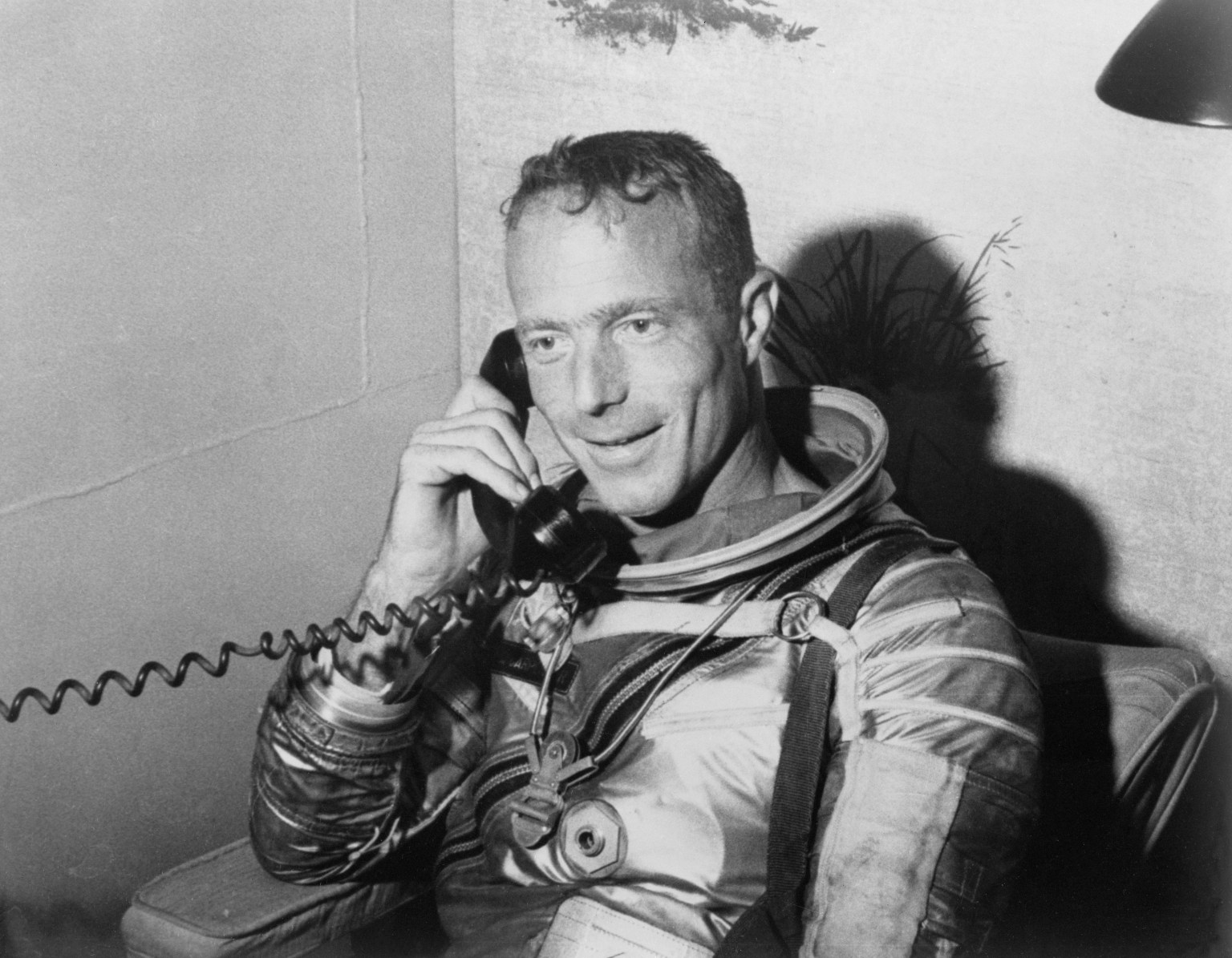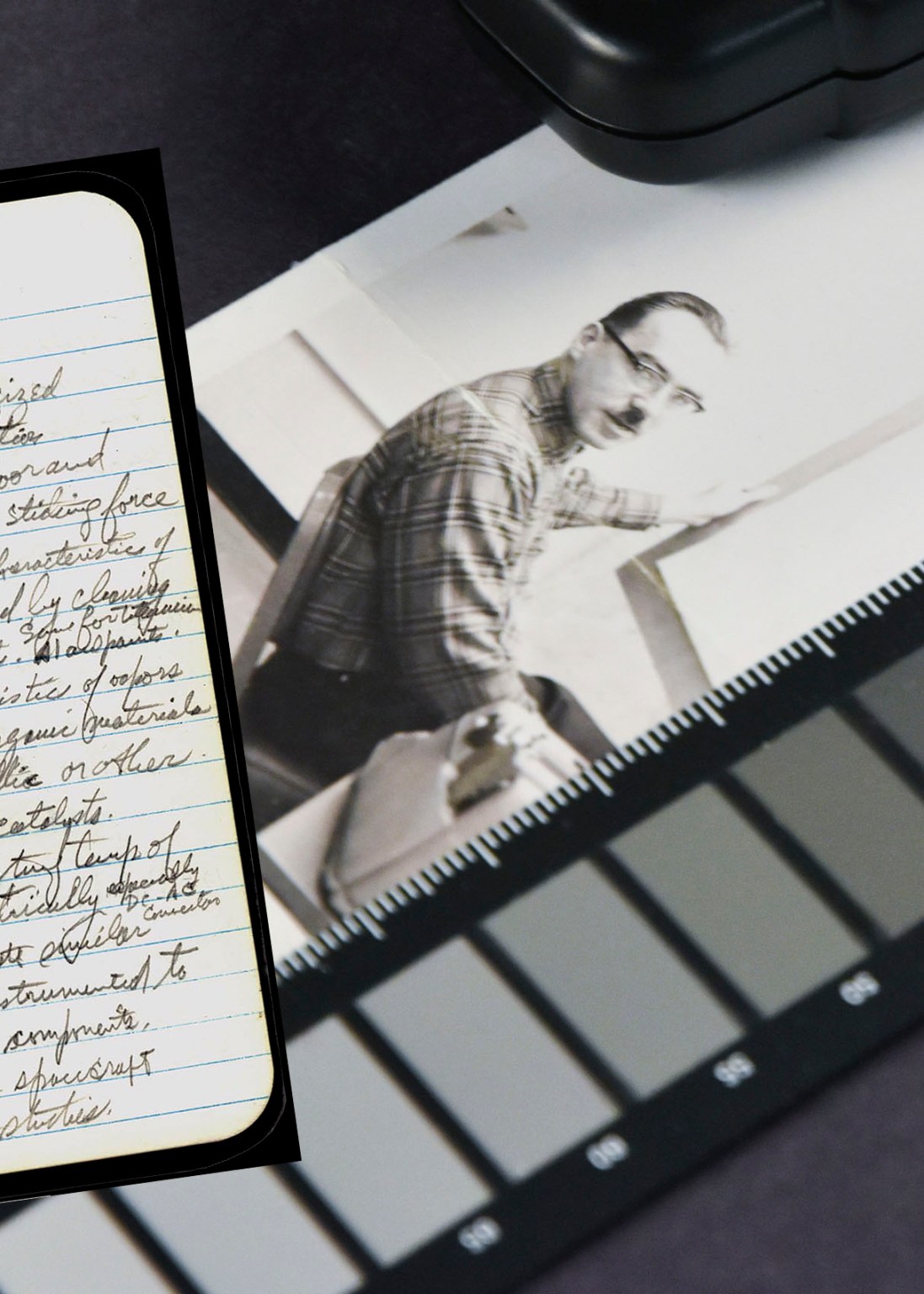Before humans actually went into space, one of the prevailing theories of the perils of space flight was that humans might not be able to survive long periods of weightlessness. For several years, there had been a serious debate among scientists about the effects of prolonged weightlessness. American and Russian scientists utilized animals—mainly monkeys, chimps and dogs—in order to test each country’s ability to launch a living organism into space and bring it back alive and unharmed.
On June 11, 1948, a V-2 Blossom launched into space from White Sands, New Mexico carrying Albert I, a rhesus monkey. Lack of fanfare and documentation made Albert an unsung hero of animal astronauts. On June 14, 1949, a second V-2 flight carrying a live Air Force Aeromedical Laboratory monkey, Albert II, attained an altitude of 83 miles. The monkey died on impact. On August 31, 1950, another V-2 was launched and carried an unanaesthetized mouse that was photographed in flight and did not survive impact. On December 12, 1949, the last V-2 monkey flight was launched at White Sands. Albert IV, a rhesus monkey attached to monitoring instruments, was the payload. It was a successful flight, with no ill effects on the monkey until impact, when it died.
On September 20, 1951, a monkey named Yorick and 11 mice were recovered after an Aerobee missile flight of 236,000 feet at Holloman Air Force Base, New Mexico. Yorick got a fair amount of press as the first monkey to live through a space flight.
On May 22, 1952, two Philippine monkeys, Patricia and Mike, were enclosed in an Aerobee nose section at Holloman Air Force Base. Patricia was placed in a seated position and Mike in a prone position to determine differences in the effects of rapid acceleration. Fired 36 miles up at a speed of 2000 mph, these two monkeys were the first primates to reach such a high altitude. Also on this flight were two white mice, Mildred and Albert. They were inside a slowly rotating drum where they could “float” during the period of weightlessness. The section containing the animals was recovered safely from the upper atmosphere by parachute. Patricia died of natural causes about two years later and Mike died in 1967, both at the National Zoological Park in Washington, DC.
The Soviets kept close tabs on what the U.S. was doing with their V-2 and Aerobee missile projects during the early 1950’s. Basing their experiments on American biomedical research, Soviet rocket pioneer Sergei Korolev, his biomedical expert Vladimir Yazdovsky, and a small team used mice, rats and rabbits as one-way passengers for their initial tests. They needed to gather data to design a cabin to carry a human being into space. Eventually they chose small dogs for this phase of testing. Dogs were chosen over monkeys because it was felt that they would be less fidgety in flight. A test with two dogs would allow for more accurate results. They chose females because of the relative ease of controlling waste.
Between 1951 and 1952, the Soviet R-1 series rockets carried nine dogs altogether, with three dogs flying twice. Each flight carried a pair of dogs in hermetically sealed containers that were recovered by parachute. Of these early space-bound hounds, a few have been remembered by name.
On August 15, 1951, Dezik and Tsygan (“Gypsy”) were launched. These two were the first canine suborbital astronauts. They were successfully retrieved. In early September 1951, Dezik and Lisa were launched. This second early Russian dog flight was unsuccessful. The dogs died but a data recorder survived. Korolev was devastated by the loss of these dogs. Shortly afterwards, Smelaya (“Bold”) and Malyshka (“Little One”) were launched. Smelaya ran off the day before the launch. The crew was worried that wolves that lived nearby would eat her. She returned a day later and the test flight resumed successfully. The fourth test launch was a failure, with two dog fatalities. However, in the same month, the fifth test launch of two dogs was successful. On September 15, 1951, the sixth of the two-dog launches occurred. One of the two dogs, Bobik, escaped and a replacement was found near the local canteen. She was a mutt, given the name ZIB, the Russian acronym for “Substitute for Missing Dog Bobik.” The two dogs reached 100 kilometers and returned successfully. Other dogs associated with this series of flights included Albina (“Whitey”), Dymka (“Smoky”), Modnista (“Fashionable”), and Kozyavka (“Gnat”).
On November 3, 1957, Sputnik 2 blasted into Earth orbit with a dog named Laika aboard. Laika, which is Russian for “Husky” or “Barker,” had the real name of Kudryavka (“Little Curly”). In the U.S. she was eventually dubbed “Muttnik.” Laika was a small, stray mongrel picked up from the street. She was hastily trained and put aboard in a metal carrier under the second Sputnik sphere. There was no time to work out any reentry strategy and Laika expired after a few hours. Sputnik 2 finally burned up in the outer atmosphere in April 1958.
Back in the U.S., on April 23, 1958 a mouse was launched in a Thor-Able “Reentry 1” test as the first launch in the Mouse in Able (MIA) project. It was lost when the rocket was destroyed after launch from Cape Canaveral. The second launch in the series was MIA-2, or Laska, in a Thor-Able “Reentry 2” test on July 9, 1958. Laska endured 60G acceleration and 45 minutes of weightlessness before perishing. Wilkie, the third mouse in the MIA series, was lost at sea after the flight from Cape Canaveral on July 23, 1958. Fourteen mice were lost when the Jupiter rocket they were aboard was destroyed after launch from Cape Canaveral on September 16, 1959.
Gordo, a squirrel monkey, was catapulted 600 miles high in a Jupiter rocket, also on December 13, 1958, one year after the Soviets launched Laika. Gordo’s capsule was never found in the Atlantic Ocean. He died on splashdown when a flotation mechanism failed, but Navy doctors said signals on his respiration and heartbeat proved humans could withstand a similar trip.
Able, an American-born rhesus monkey, and Baker, a South American squirrel monkey, followed on May 28, 1959, aboard an Army Jupiter missile. Launched in the nose cone, the two animals were carried to a 300-mile altitude, and both were recovered unharmed. However, Able died June 1 on the operating table from effects of anesthesia, as doctors were about to remove an electrode from under her skin. Baker died of kidney failure in 1984 at age 27.
Four black mice were launched on June 3, 1959, on Discoverer 3, part of the Corona program of U.S. spy satellites, which was launched from Vandenberg Air Force Base on a Thor Agena A rocket. This was the only Discoverer flight with an animal payload. The mice died when the Agena upper stage fired downward, driving the vehicle into the Pacific Ocean. The first try at launch was scrubbed after the telemetry indicated no sign of activity in the capsule and the first crew of four black mice was found dead. The mouse cages had been sprayed with krylon to cover rough edges, and the mice had found the krylon tastier than their formula and overdosed on it. The second try at launch with a backup mouse crew was halted when the humidity sensor in the capsule indicated 100-percent humidity. The capsule was opened up and it was discovered that the sensor was located underneath one of the mouse cages; it was unable to distinguish the difference between water and mouse urine. After the sensor was dried out, the launch proceeded.
Sam, a rhesus monkey, was one of the most well known monkeys of the space program. His name was an acronym for the U.S. Air Force School of Aviation Medicine at Brooks Air Force Base, Texas. He was launched on December 4, 1959, housed in a cylindrical capsule within the Mercury spacecraft atop a Little Joe rocket in order to test the launch escape system (LES). Approximately one minute into the flight, traveling at a speed of 3685 mph, the Mercury capsule aborted from the Little Joe launch vehicle. After attaining an altitude of 51 miles, the spacecraft landed safely in the Atlantic Ocean. Sam was recovered, several hours later, with no ill effects from his journey. He was later returned to the colony in which he trained, where he died in November 1982 and his remains were cremated.
Miss Sam, another rhesus monkey and Sam’s mate, was launched on January 21, 1960, for another test of the LES. The Mercury capsule attained a velocity of 1800 mph and an altitude of 9 miles. After landing in the Atlantic Ocean 10.8 miles downrange from the launch site, Miss Sam was also retrieved in overall good condition. She was also returned to her training colony until her death on an unknown date.
In the Soviet Union, meanwhile, testing was also taking place on more dogs. On July 28, 1960, Bars (“Panther” or “Lynx”) and Lisichka (“Little Fox”) were launched on a Korabl Sputnik, a prototype of the Vostok manned spacecraft. The booster exploded on launch, killing the two dogs. On August 19, 1960, Belka (“Squirrel”) and Strelka (“Little Arrow”) were launched on Sputnik 5 or Korabl Sputnik 2, along with a gray rabbit, 40 mice, 2 rats, and 15 flasks of fruit flies and plants. Strelka later gave birth to a litter of six puppies one of which was given to JFK as a gift for his children. Pchelka (“Little Bee”) and Muska (“Little Fly”) were launched onboard Sputnik 6 or Korabl Sputnik 3 on December 1, 1960 along with mice, insects, and plants. The capsule and animals burned up on re-entry. On December 22, 1960, soviet scientists attempted to launch Damka (“Little Lady”) and Krasavka (“Beauty”) on a Korabl Sputnik. However, the upper rocket stage failed and the launch was aborted. The dogs were safely recovered after their unplanned suborbital flight. On March 9, 1961, another Russian dog, Chernushka (“Blackie”) was launched on Sputnik 9 or Korabl Sputnik 4. Chernushka was accompanied into space with a dummy cosmonaut, some mice, and a guinea pig. Zvezdochka (“Little Star”) was launched onboard Sputnik 10 or Korabl Sputnik 5 on March 25, 1961. The dog went up with simulated cosmonaut “Ivan Ivanovich” and successfully tested the spacecraft’s structure and systems.
On January 31, 1961, Ham, whose name was an acronym for Holloman Aero Med, became the first chimpanzee in space, aboard the Mercury Redstone rocket on a sub-orbital flight very similar to Alan Shepard’s. Ham was brought from the French Camaroons, West Africa, where he was born July 1957, to Holloman Air Force Base in New Mexico in 1959. The original flight plan called for an altitude of 115 miles and speeds ranging up to 4400 mph. However, due to technical problems, the spacecraft carrying Ham reached an altitude of 157 miles and a speed of 5857 mph and landed 422 miles downrange rather than the anticipated 290 miles. Ham performed well during his flight and splashed down in the Atlantic Ocean 60 miles from the recovery ship. He experienced a total of 6.6 minutes of weightlessness during a 16.5-minute flight. A post-flight medical examination found Ham to be slightly fatigued and dehydrated, but in good shape otherwise. Ham’s mission paved the way for the successful launch of America’s first human astronaut, Alan B. Shepard, Jr., on May 5, 1961. Upon the completion of a thorough medical examination, Ham was placed on display at the Washington Zoo in 1963 where he lived alone until September 25, 1980. He then was moved to the North Carolina Zoological Park in Asheboro. Upon his death on January 17, 1983, Ham’s skeleton would be retained for ongoing examination by the Armed Forces Institute of Pathology. His other remains were respectfully laid to rest in front of the International Space Hall of Fame in Alamogordo, New Mexico.
Goliath, a one-and-a-half-pound squirrel monkey, was launched in an Air Force Atlas E rocket on November 10, 1961. The SPURT (Small Primate Unrestrained Test) monkey was killed when the rocket was destroyed 35 seconds after launch from Cape Canaveral.
Enos became the first chimp to orbit the earth on November 29, 1961, aboard a Mercury Atlas rocket. Although the mission plan originally called for three orbits, due to a malfunctioning thruster and other technical difficulties, flight controllers were forced to terminate Enos’ flight after two orbits. Enos landed in the recovery area and was picked up 75 minutes after splashdown. He was found to be in good overall condition and both he and the Mercury spacecraft performed well. His mission concluded the testing for a human orbital flight, achieved by John Glenn on February 20, 1962. Enos died at Holloman Air Force Base of a non-space related case of dysentery 11 months after his flight.
On October 18, 1963, French scientists launched the first cat into space on a Veronique AGI sounding rocket No. 47. The cat, named Félicette, was successfully retrieved after a parachute descent, but a second feline flight on October 24 ran into difficulties that prevented recovery.
Back in the Soviet Union, the dogs Veterok (“Breeze”) and Ugoyok (“Little Piece Of Coal”) were launched aboard Kosmos 110 by the Soviet Union on February 22, 1966. The flight was an evaluation of prolonged effects during space travel of radiation from the Van Allen Belts on animals. Twenty-one days in space still stand as a canine record and was only surpassed by humans in June 1974 with the flight of Skylab 2.
The year 1968 saw the U.S.S.R. turn once again to the animal kingdom for the first passengers of their new, manned moon ship. The first successful Zond (“probe”) launch was on September 15, 1968, when Zond 5 was launched. A biological payload of turtles, wine flies, mealworms, plants, seeds, bacteria, and other living matter was included in the flight. On September 18, 1968, the spacecraft flew around the Moon. On September 21, 1968, the reentry capsule entered the earth’s atmosphere, braked aerodynamically, and deployed parachutes at 7 km. The capsule splashed down in the Indian Ocean and was successfully recovered, but a failure of the reentry guidance system subjected the biological specimens to a ballistic 20G reentry. Zond 6 was launched on a lunar flyby mission on November 10, 1968. The spacecraft carried a biological payload similar to Zond 5. Zond 6 flew around the Moon on November 14, 1968. Unfortunately, the spacecraft lost a gasket on the return flight resulting in the loss of cabin atmosphere and destruction of the biological specimens.
From 1966 to 1969, the U.S. launched three missions in the Biosatellite series. A total of six flights were planned. The first mission in the Biosatellite series, Biosatellite I, was launched on December 14, 1966, from Cape Kennedy by a Delta rocket. The scientific payload, consisting of 13 select biology and radiation experiments, was exposed to microgravity during 45 hours of Earth-orbital flight. Experimental biology packages on the spacecraft contained a variety of specimens, including insects, frog eggs, microorganisms, and plants. Reentry into the Earth’s atmosphere was not achieved because the retrorocket failed to ignite and the biosatellite was never recovered. Although not all the mission objectives were accomplished, the Biosatellite I experience provided technical confidence in the program because of excellent performance in most other areas.
Improvements were made in hardware, prelaunch tests, and procedures before Biosatellite II was launched on September 7, 1967 from Cape Kennedy. The planned three-day mission was recalled early because of the threat of a tropical storm in the recovery area, and because of a communication problem between the spacecraft and the tracking systems. It carried a biological payload similar to Biosatellite I. The primary objective of the Biosatellite II mission was to determine if organisms were more, or less, sensitive to ionizing radiation in microgravity than on Earth. To study this question, an artificial source of radiation (Strontium 85) was supplied to a group of experiments mounted in the forward part of the spacecraft.
The last spacecraft in the series, Biosatellite III, was launched on June 28, 1969. On board was a single, male, pig-tailed monkey (Macaca nemestrina) named Bonnie, weighing 6 kg, for a planned 30-day mission. The mission objective was to investigate the effect of space flight on brain states, behavioral performance, cardiovascular status, fluid and electrolyte balance, and metabolic state. However, after just under nine days in orbit, the mission was terminated because of the subject’s deteriorating health. Bonnie died eight hours after he was recovered due to a heart attack brought about by dehydration.
After the manned lunar landing of Apollo 11, the role of animals was limited to the status of “biological payload.” The range of species broadened to include rabbits, turtles, insects, spiders, fish, jellyfish, amoebae, and algae. Although they were still used in tests dealing with long-range health effects in space, tissue development, and mating in a zero-g environment, etc., animals no longer made the front pages. One exception to this was one of the last Apollo flights, Skylab 3, which launched on July 28, 1973. On board were Anita and Arabella, two common Cross spiders. Tests were set up to record the spiders’ successful attempts to spin webs in space.
From 1973 to 1996, Russia, or its predecessor, the Soviet Union, launched a series of life sciences satellites called Bion. Research partners have included Austria, Bulgaria, Canada, China, the Commonwealth of Independent States, Czechoslovakia, East Germany, the European Space Agency, France, Germany, Hungary, Lithuania, Poland, Romania, Ukraine, and the United States. The Bion spacecraft is a modified Vostok type and is launched on a Soyuz rocket from the Plesetsk Kosmodrome in northern Russia.
Bion missions are typically put under the Kosmos umbrella name, used for a variety of different satellites including spy satellites. The first Bion launch was Kosmos 605 launched on October 31, 1973. The satellite carried tortoises, rats, insects, and fungi on a 22-day mission. Other missions have also carried plants, mold, quail eggs, fish, newts, frogs, cells, and seeds.
Starting with Bion 6 (Kosmos 1514), these missions have carried pairs of monkeys. Bion 6/Kosmos 1514 was launched December 14, 1983, and carried the monkeys Abrek and Bion on a five-day flight. Bion 7/Kosmos 1667 was launched July 10, 1985 and carried the monkeys Verny (“Faithful”) and Gordy (“Proud”) on a seven-day flight. Bion 8/Kosmos 1887 was launched September 29, 1987, and carried the monkeys Yerosha (“Drowsy”) and Dryoma (“Shaggy”) on a 13-day flight. Yerosha partially freed himself from his restraints and explored his orbital cage during the mission. On reentry, Bion 8 missed its touchdown point by 1850 miles, resulting in the death of several fish on board due to the frigid weather. Bion 9/Kosmos 2044 was launched September 15, 1989, and carried the monkeys Zhakonya and Zabiyaka (“Troublemaker”) on a 14-day flight. Temperature problems onboard resulted in the loss of ant and earthworm experiments.
Bion 10/Kosmos 2229 was launched December 29, 1992, and carried the monkeys Krosh (“Tiny”) and Ivasha on a 12-day flight. Bion 10 was recovered two days early due to thermal control problems that resulted in unacceptably high onboard temperatures. Seven of fifteen tadpoles onboard died as a result of the high temperatures. Both monkeys were treated for dehydration and recovered. One monkey also suffered weight loss when he went without food for three days. Bion 11 was launched December 24, 1996, and carried the monkeys Lapik and Multik (“Cartoon”) on a 14-day flight. Tragically, Multik died the day after the capsule recovery during his post-landing medical operation and checkup. Multik’s death raised new questions regarding the ethics of using animals for research. NASA has dropped out of participation in a planned Bion 12 mission.
From 1983 to the present day, the Space Shuttle has flown over two dozen Spacelab experimental packages in its payload bay. Life-science Spacelab missions have included experiments involving the human astronauts as well as the animals and insects carried on these missions. STS-51-B (Spacelab-3) launched April 29, 1985. STS-61-A (Spacelab-D1) launched October 30, 1985. STS-40 (Spacelab Life Sciences 1 SLS-1) launched June 5, 1991. STS-42 (International Microgravity Laboratory-1 IML-1) launched January 22, 1992. STS-47 (Spacelab-J), a joint venture between NASA and the National Space Development Agency of Japan (NASDA) launched September 12, 1992. STS-65 (IML-2) launched July 8, 1994. A biological payload record was set on April 17, 1998, when over two thousand creatures joined the seven-member crew of the shuttle Columbia (STS-90) for a sixteen-day mission of intensive neurological testing (NEUROLAB).Over the past 50 years, American and Soviet scientists have utilized the animal world for testing. Despite losses, these animals have taught the scientists a tremendous amount more than could have been learned without them. Without animal testing in the early days of the human space program, the Soviet and American programs could have suffered great losses of human life. These animals performed a service to their respective countries that no human could or would have performed. They gave their lives and/or their service in the name of technological advancement, paving the way for humanity’s many forays into space.
By Tara Gray, 1998



























